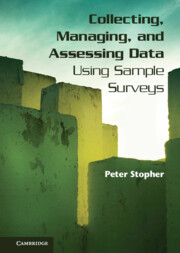Book contents
- Frontmatter
- Contents
- Figures
- Tables
- Acknowledgements
- 1 Introduction
- 2 Basic statistics and probability
- 3 Basic issues in surveys
- 4 Ethics of surveys of human populations
- 5 Designing a survey
- 6 Methods for conducting surveys of human populations
- 7 Focus groups
- 8 Design of survey instruments
- 9 Design of questions and question wording
- 10 Special issues for qualitative and preference surveys
- 11 Design of data collection procedures
- 12 Pilot surveys and pretests
- 13 Sample design and sampling
- 14 Repetitive surveys
- 15 Survey economics
- 16 Survey implementation
- 17 Web-based surveys
- 18 Coding and data entry
- 19 Data expansion and weighting
- 20 Nonresponse
- 21 Measuring data quality
- 22 Future directions in survey procedures
- 23 Documenting and archiving
- References
- Index
14 - Repetitive surveys
Published online by Cambridge University Press: 05 June 2012
- Frontmatter
- Contents
- Figures
- Tables
- Acknowledgements
- 1 Introduction
- 2 Basic statistics and probability
- 3 Basic issues in surveys
- 4 Ethics of surveys of human populations
- 5 Designing a survey
- 6 Methods for conducting surveys of human populations
- 7 Focus groups
- 8 Design of survey instruments
- 9 Design of questions and question wording
- 10 Special issues for qualitative and preference surveys
- 11 Design of data collection procedures
- 12 Pilot surveys and pretests
- 13 Sample design and sampling
- 14 Repetitive surveys
- 15 Survey economics
- 16 Survey implementation
- 17 Web-based surveys
- 18 Coding and data entry
- 19 Data expansion and weighting
- 20 Nonresponse
- 21 Measuring data quality
- 22 Future directions in survey procedures
- 23 Documenting and archiving
- References
- Index
Summary
Introduction
It is quite common that surveys are designed to be conducted on the same population on repeated occasions. Sometimes such repeated surveys are to be treated simply as an unrelated series of surveys, which provide, on each occasion, more up-to-date information on the subject population. At other times the purpose of the repeated surveys is to measure change from one period of time to another. Especially when change is to be measured from one period to another with the same population, there are four methods by which the samples may be drawn on the repeated occasions.
Samples may be drawn independently of one another, such that the chance of any population member being included in successive surveys is extremely low, or even intentionally avoided.
Samples may be drawn so that there is overlap between the sample on one occasion and the sample on the next occasion. In such a case, part of the sample will be different on each occasion, and part will be included in at least two successive occasions.
The sample on a second and subsequent occasion may be drawn as a subsample of the first occasion. In this case, all the sample members on occasions after the first will have been included in the first survey sample, but not all those included in the first survey sample will be measured in succeeding samples.
The sample on each occasion consists of exactly the same subjects, with no omissions and no additions. This is also known as a true panel survey.
Each of these four methods of repetition has different implications for the calculation of population values and standard errors, especially when there is interest in calculating differences between two or more occasions. The four types of sample are illustrated schematically in Figure 14.1.
- Type
- Chapter
- Information
- Collecting, Managing, and Assessing Data Using Sample Surveys , pp. 337 - 355Publisher: Cambridge University PressPrint publication year: 2012



